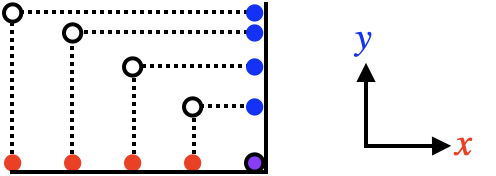2D Kinematics
When dealing with forces in two dimensions we saw that the horizontal and vertical forces balance separately. The same principle holds true in two-dimensional kinematics as well: the horizontal and vertical motions of an object are independent of each other.For example, here's the motion diagram of a ball (represented by the white circles) that is pushed from the edge of a table:

Because the ball is in free-fall, its acceleration is downward: it has a vertical acceleration of $a_y=-9.8\u{m/s^2}$, but a horizontal acceleration of $a_x=0$ because there is no net horizontal force. If you look at the shadows of the ball on the floor, they are moving at a constant velocity (because they are evenly spaced), which is what a ball in one dimension would do if it had a horizontal acceleration of zero. The shadows on the wall, on the other hand, are speeding up in just the way you would expect if the ball were simply dropped from that height instead of pushed off a table.
Variables
| Horizontal | Vertical |
| $\Delta x$ | $\Delta y$ |
| $v_{ix}$ | $v_{iy}$ |
| $v_{fx}$ | $v_{fy}$ |
| $a_x$ | $a_y$ |
| Both: | $\Delta t$ |
What this means is that we can solve the horizontal and vertical kinematics problems separately, with time being the one variable that belongs to both. We now have nine variables and four independent equations (ten total to choose from), which means we need to have five knowns before we can solve for the others:
Column
Horizontal
$$\begin{align} v_{fx}&=v_{ix}+a_x\Delta t\\ \Delta x&=\frac12(v_{ix}+v_{fx})\Delta t\\ \Delta x&=v_{ix}\Delta t+\frac12 a_x\Delta t^2\\ \Delta x&=v_{fx}\Delta t-\frac12 a_x\Delta t^2\\ v_{fx}^2&=v_{ix}^2+2a_x\Delta x\\ \end{align}$$
Column
Vertical
$$\begin{align} v_{fy}&=v_{iy}+a_y\Delta t\\ \Delta y&=\frac12 (v_{iy}+v_{fy})\Delta t\\ \Delta y&=v_{iy}\Delta t+\frac12 a_y\Delta t^2\\ \Delta y&=v_{fy}\Delta t-\frac12 a_y\Delta t^2\\ v_{fy}^2&=v_{iy}^2+2a_y\Delta y\\ \end{align}$$